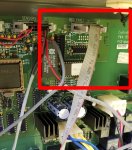I am working on decoding the signals sent from my Sundance 850 control panel J7 to the topside controls. I believe that if I can decode these signals, I can create a non-obtrusive wifi remote control without degrading the built in protections for the tub. This is a personal venture to add remote temperature adjustment and put the pumps on my own schedule. The plan is to build in a raspberry pi with a python program to run the button pushes remotely. There is almost zero info on these circuits online. The only thing that comes close is THIS.
What I have:
I have oscilloscope readings of the 10 pins that make up the J7 jumper on the 850. I can tell what they are (hz, voltage, wave form), but not necessarily how to interpret them. I am planning on getting some more readings to see if I can identify all the different button presses. I can get printouts of all the clock timings and wave types, along with the button presses in action.
I am hopeful that I can mimic with a signal generator the button pushes, as though I was standing at the tub. I don't care as much about knowing the current state of the pumps, but the state is visible on the topside panel so it should be theoretically possible..
I also want to read off the temp. I believe I made progress on this front. The logic analyzer picked up a signal on one of the leads of
0x60 which equals 96 in decimal. This was equal to the current temp, but I can't confirm that that was what the reading was, because I got some other random numbers too. Until I can interpret the signals, I don't think I can extract usable data for a program.
If anyone is feeling adventurous, can help reverse engineer a Sundance board, or has some engineering schematics for the 850 lying around any help would be greatly appreciated.
What I have:
I have oscilloscope readings of the 10 pins that make up the J7 jumper on the 850. I can tell what they are (hz, voltage, wave form), but not necessarily how to interpret them. I am planning on getting some more readings to see if I can identify all the different button presses. I can get printouts of all the clock timings and wave types, along with the button presses in action.
I am hopeful that I can mimic with a signal generator the button pushes, as though I was standing at the tub. I don't care as much about knowing the current state of the pumps, but the state is visible on the topside panel so it should be theoretically possible..
I also want to read off the temp. I believe I made progress on this front. The logic analyzer picked up a signal on one of the leads of
0x60 which equals 96 in decimal. This was equal to the current temp, but I can't confirm that that was what the reading was, because I got some other random numbers too. Until I can interpret the signals, I don't think I can extract usable data for a program.
If anyone is feeling adventurous, can help reverse engineer a Sundance board, or has some engineering schematics for the 850 lying around any help would be greatly appreciated.




